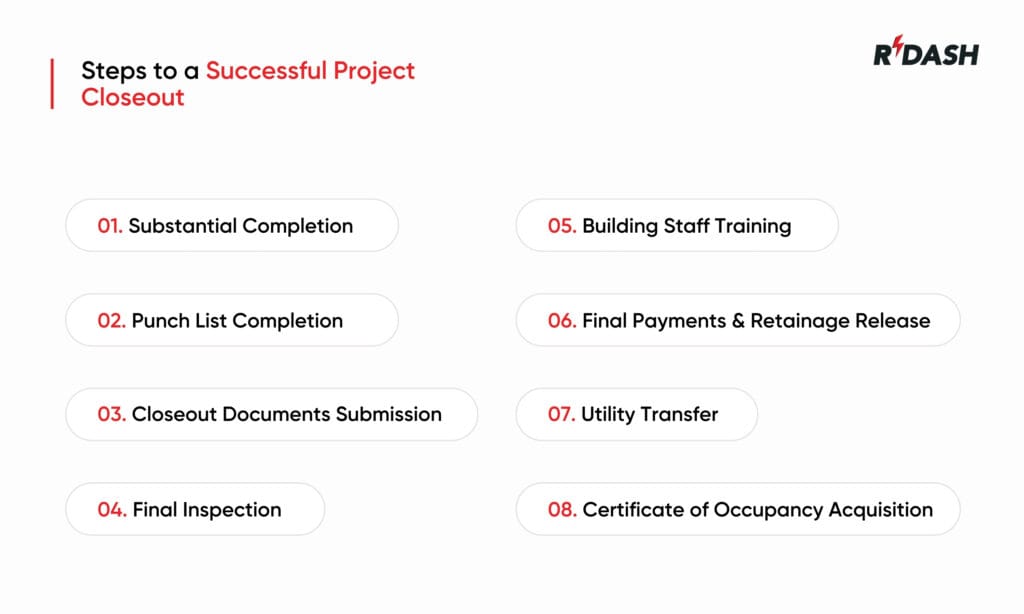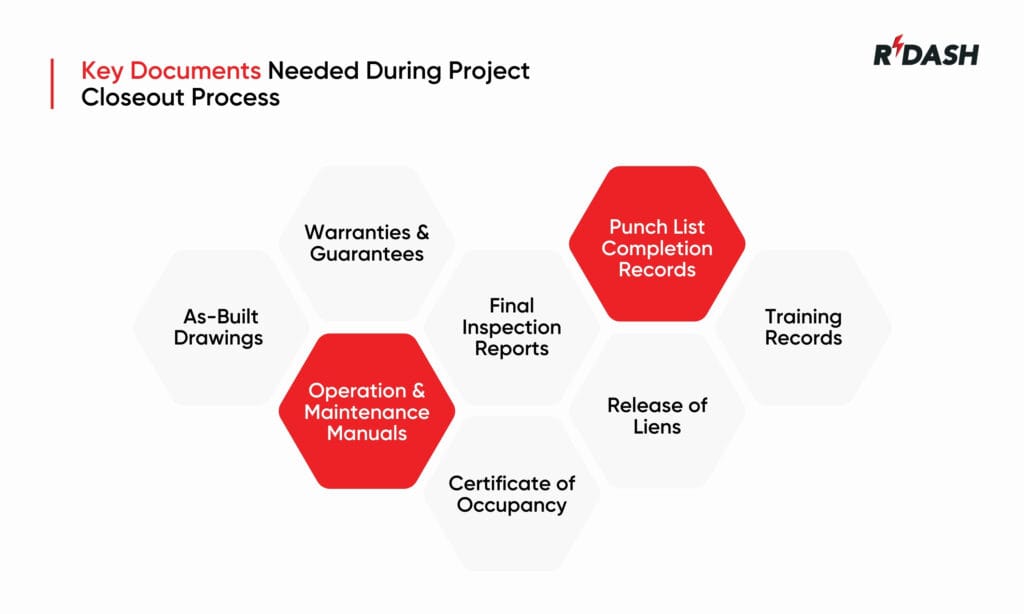Successfully concluding a construction project involves far more than completing the physical build. The closeout phase is critical, serving to ensure that every element of the project aligns with the stipulated requirements, contractual terms, and regulations. This phase marks the transition from construction completion to the building’s operational status. Here, we delve into the essential components and systematic steps required for an effective construction project closeout.
Essential elements of construction closeout
The closeout phase is characterized by detailed planning, robust organization, and effective communication, each of which is crucial for a smooth transition:
- Planning: Initiating closeout planning from the project’s outset is crucial. It should include setting clear objectives, establishing deadlines, and outlining the documentation process, all aimed at avoiding last-minute hurdles and ensuring a thorough conclusion.
- Organization: Effective organization ensures that all relevant documents, including contracts, manuals, and warranty papers, are correctly cataloged and accessible. This is vital for efficient handover and future reference.
- Communication: Maintaining transparent and ongoing communication between the construction team, stakeholders, and future building administrators is essential. Effective communication helps to ensure that all parties are aligned and informed, facilitating a seamless transition.
Key steps for a successful project wrap-up
A methodical approach to project closeout can significantly enhance overall project success and client satisfaction. Here are the critical steps involved:

- Substantial Completion: This is achieved when the project is deemed sufficiently complete for its intended use, notwithstanding some minor unresolved items.
- Completion of Punch List Items: The punch list, which is compiled during final walkthroughs, includes any remaining discrepancies or minor issues that must be resolved. Addressing these efficiently is crucial for compliance with the project specifications.
- Submission of Closeout Documents: Essential documents such as as-built drawings, operational and maintenance manuals, and warranty documents must be compiled and handed over. These are crucial for the operational phase of the building.
- Final Inspection: This involves a comprehensive review by a designated inspector to confirm that all aspects of the building meet the required standards and codes. This step is critical for ensuring the building’s readiness for occupancy.
- Training of Building Staff: It’s important to train the client’s staff on how to operate and maintain the new installations and systems. Effective training ensures the building operates smoothly from the outset.
- Final Payments and Release of Retainage: Ensuring that all subcontractors have been paid and that any withheld funds are released is vital for closing the financial aspects of the project.
- Transfer of Utilities and Facilities: Managing the transfer of all utilities to the building owner and confirming that all systems are fully functional is essential for operational transition.
- Acquisition of Certificate of Occupancy: Obtaining this certificate verifies that the building is safe and meets all local legal standards, allowing it to be occupied.
What happens when closeout goes poorly
A poorly managed closeout process can have significant ramifications for all project stakeholders. Here are some potential consequences:
- Delayed Project Delivery: Inefficient closeout can lead to delays in project delivery, impacting the scheduled occupancy and use of the building. This can also lead to financial penalties or loss of reputation.
- Financial Disputes: Incomplete documentation and unresolved claims can lead to disputes over payments, resulting in withheld funds or legal challenges.
- Operational Inefficiencies: Without proper handover of operational manuals and training, the building’s staff may face challenges in managing and maintaining the facility, leading to increased operational costs and equipment failures.
- Compliance Issues: Failure to obtain necessary approvals and certificates, like the Certificate of Occupancy, can legally prevent the building from being used, causing significant inconvenience and financial loss.
Must-Have documents for project closeout process
A well-organized closeout process relies on several key documents that facilitate a smooth transition from construction to operation:

- As-Built Drawings: These are updated drawings reflecting any modifications made during the construction process, and they provide an accurate representation of the final construction. These drawings are essential for future renovations or maintenance as they offer a definitive reference of the building’s executed design.
- Operation and Maintenance Manuals: These manuals are comprehensive guides for every piece of equipment installed within the facility. They are critical for the ongoing maintenance and operation teams, ensuring that each component is used correctly and maintained according to manufacturer recommendations, which is essential for safety and efficiency.
- Warranties and Guarantees: These documents are crucial as they detail the warranties covering materials and workmanship throughout the building. They protect the owner by providing recourse for any future issues related to defective materials or craftsmanship, facilitating the process of claims and repairs.
- Punch List Completion Records: Documenting the resolution of all items on the punch list, these records are proof that all minor defects or unfinished elements noted during the final walkthroughs have been satisfactorily addressed and corrected, ensuring the project meets the agreed standards.
- Final Inspection Reports: These are the detailed accounts from the final inspections, confirming that the project complies with all relevant codes, regulations, and standards. These reports are critical for identifying any last-minute issues that need to be resolved before the building can be deemed safe and ready for occupancy.
- Certificate of Occupancy: Issued by a local government or regulatory body, this certificate is a crucial document that officially allows the building to be occupied. It confirms that the building adheres to all legal and safety standards, and it is often required for insurance and financing purposes.
- Release of Liens: This legal document is essential to ensure that there are no outstanding financial claims or liens against the property related to the construction work. It clears the way for the owner to take uncontested possession of the building.
- Training Records: Keeping records of all training sessions provided to the building’s operational staff on how to manage and maintain new systems and equipment is crucial. These records help ensure that the staff is well-prepared to take over the management and maintenance of the building, promoting operational efficiency from day one.
Responsibilities during closeout and after closeout
During Closeout:
- Construction Manager: Oversees the entire closeout process, ensuring that all contractual obligations are fulfilled, documents are submitted, and final inspections are arranged.
- Contractors and Subcontractors: Complete all work including the resolution of punch list items and submit all necessary documentation and warranties.
- Owner: Reviews and approves all submitted documents and makes final payments once satisfied with the work.
After Closeout:
- Building Owner: Assumes responsibility for the building’s operation and maintenance, utilizing the provided manuals and training.
- Facility Manager: Takes charge of the day-to-day operations and ensures that the building systems function efficiently based on the training and documents provided.
- Construction Team: Remains available to address any post-closeout issues, such as warranty claims or deficiencies noted after the project handover.
A thorough and meticulously managed closeout process not only marks the successful completion of a construction project but also sets the foundation for efficient and compliant building operations, safeguarding the interests of all stakeholders involved.






